The Subtle Art of Bedroom Doorknobs: A Comprehensive Exploration
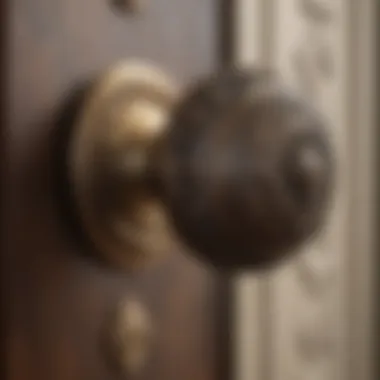
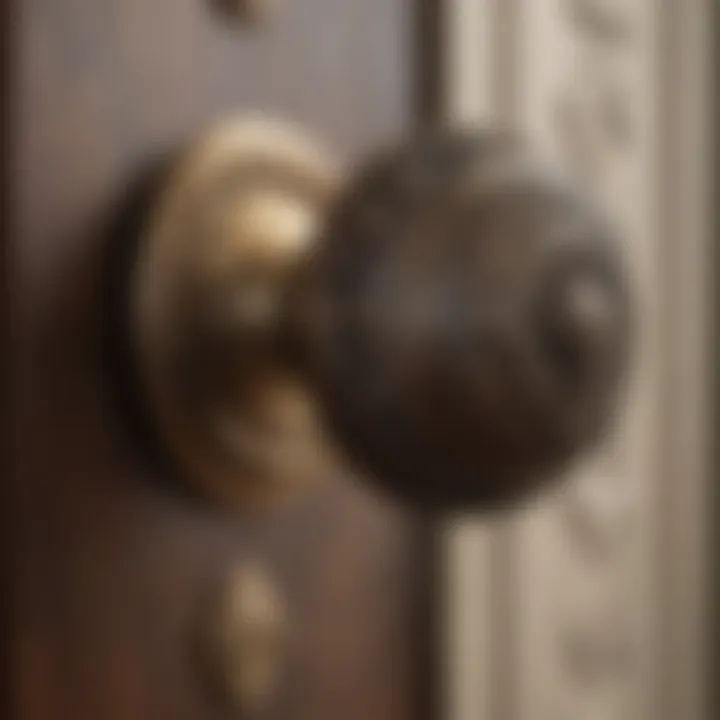
Intro
When it comes to bedroom aesthetics, we often get caught up in the larger elements—beds, dressers, even the paint on the walls. Yet, one small detail that's frequently given the cold shoulder is the doorknob. An unassuming part of our daily routine, doorknobs say a lot about our bedrooms. They can elevate or diminish the overall vibe of the space. This article explores the nuances of doorknobs, shedding light on their historical significance, practical functions and creative designs that can transform a bedroom from ordinary to extraordinary.
In understanding these objects, we can appreciate their role in our homes and how they serve as both functional items and work of art.
Current Trends
As we step into the modern era, bedroom doorknobs have evolved far beyond their basic utility. Homeowners are now viewing doorknobs as significant design elements that contribute to the overall ambiance of their space. This trend shifts focus from mere function to aesthetic appeal. Notably, color palettes and popular styles are emerging and reshaping the way we consider these small fixtures.
Color Palettes
The colors we choose for bedroom doorknobs can either harmonize with or contrast the various other elements in the room. Here are some trending options:
- Muted Tones: Soft pastels or earth shades that blend seamlessly with bedroom decor, providing a subtle touch without drawing too much attention.
- Bold Accents: Vibrant hues like deep blues or rich greens that serve as statement pieces, allowing them to stand out.
- Metallic Finishes: Silver and bronze are back in a big way, offering a luxurious feel while maintaining a classic charm.
Popular Styles
Much like in fashion, doorknob styles have their own trends. Here are a few that are gaining traction:
- Minimalist Designs: Simple, sleek knobs with clean lines that exude elegance and sophistication.
- Vintage Looks: An uptick in nostalgia has homeowners leaning toward antique finishes and intricate details, reminiscent of earlier eras.
- Natural Elements: Materials like wood or stone are being embraced, emphasizing a more organic feel within the space.
"It's fascinating how something so small can pack such a punch in terms of design. A doorknob can bridge the gap between practicality and personal expression."
Visual Ideas
In this section, we explore how visuals play a crucial role in understanding the effectiveness of these small yet significant components.
Gallery of Styled Bedrooms
Here are few curated images showcasing varied doorknob designs integrated into different bedroom styles:
- Modern Simplicity: Stainless steel knobs placed against white doors in a minimalist bedroom.
- Chic Vintage: Ornate brass handles that rest beautifully on an oak door in a rustic-themed bedroom.
- Eclectic Fusion: A mix of wooden doorknobs and colorful painted doors, creating a whimsical touch to a playful kids room.
Before-and-After Transformations
The visual transformation that the right doorknob can bring to a bedroom is nothing short of remarkable:
- Before: A bland, standard doorknob that goes unnoticed.
- After: A beautifully crafted ceramic knob that enhances the overall decor and adds personality to the bedroom.
As we move forward in understanding the intricate dance between aesthetics and practicality, it becomes clear that doorknobs hold an essential role in our most personal spaces, making the act of selecting them an enjoyable yet crucial task.
Historical Context of Bedroom Doorknobs
The journey of bedroom doorknobs reflects much more than mere functionality; it speaks volumes about the evolution of household design and the underlying social constructs of various time periods. From serving as simple latches for privacy to becoming complex symbols of status and style, doorknobs have undergone considerable change. This exploration into their historical context not only sheds light on their practical importance but also enhances our understanding of how they fit into broader design philosophies and cultural shifts.
Evolution of Doorknobs
The timeline of doorknobs traces back to ancient civilizations. Early civilizations, like the Egyptians and Romans, employed basic mechanisms for securing spaces. These were often made from rudimentary materials that offered minimal security and functionality. Over time, the doorknob evolved significantly. This change began to take shape in the Middle Ages, where metal craftsmanship made its debut. Blacksmiths started crafting intricate doorknobs, which not only served a purpose but also showcased artisanship. The emergence of standardized manufacturing in the 19th century led to a wider availability of designs, transitioning doorknobs from custom pieces to mass-produced items.
By the late 1800s, doorknobs sported a variety of styles, from ornate Victorian pieces embellished with intricate patterns to simpler, more utilitarian forms in homes that favored efficiency over extravagance. With the rise of different architectural styles, such as Arts and Crafts, doorknobs began reflecting the essence of their respective movements by integrating natural materials and clean lines.
Cultural Variations
Cultural influences play a vital role in the design and usage of doorknobs around the world. In traditional Japanese homes, for example, sliding doors prevail, using tsuitate style where simple wooden handles serve a practical purpose without elaborate adornments. This minimalist approach emphasizes functionality and simplicity, leading to a serene aesthetic.
In contrast, European styles often embraced opulence. Art Nouveau and Baroque styles favored doorknobs that were highly decorative, made from materials like brass and ceramics. They embodied a sense of wealth and artistry, transforming doorknobs into focal points in a room. The significance of cultural context can’t be understated. It's fascinating to observe how each culture has approached the doorknob – crafting items that resonate with their unique values and artistic expressions.
The Role in Architectural Trends
The integration of doorknobs into architectural movements illustrates how design principles have shifted over the decades. In the Colonial period of the United States, doorknobs were often simple yet functional, fitting harmoniously with the symmetrical design of the homes. However, as architectural trends evolved, so did the role of doorknobs. The Victorian era ushered in a period of extravagant details, where doorknobs matched the richness of the elaborate homes they adorned.
In more modern constructs, where open-floor plans and minimalist designs reign supreme, doorknobs began reflecting these changes. Lever handles emerged as a popular choice, providing ease of use and aligning with the trend towards simplicity. The dialogue between doorknob design and architectural style is a compelling narrative that underscores how these minor elements contribute to the overarching aesthetic and functional experience of a space.
"A doorknob is not just a means of entry; it represents the character and intention of the spaces it secures."
In summary, the historical context of bedroom doorknobs serves as a lens through which we can examine broader themes of design and functionality. With each evolution, a story emerges that reflects changing societal values, artistic preferences, and cultural nuances. This understanding enriches our appreciation for what may at first seem like a trivial detail, underlining its potential impact on the design and ambiance of a bedroom.
Functional Importance of Doorknobs
When it comes to bedrooms, many may think the look of the doorknob is an afterthought, but that's a common misstep. The doorknob serves multiple functions that affect not just security, but the user experience and longevity in relation to maintenance as well. By focusing on the functional aspects of doorknobs, it becomes clear how these small details can create a harmonious living environment that aligns with a homeowner's lifestyle and needs.
Security Features
The primary role of any doorknob is, of course, to secure entry to a room. In bedrooms, where privacy and safety are paramount, the types of locks available on doorknobs become particularly vital. Many modern doorknobs come equipped with features like deadbolts or smart capacity that can be integrated with home security systems. The advanced locking mechanisms offer not only peace of mind but also deterrent factors for potential intruders.
- Deadbolts: Often seen as an essential add-on, deadbolts provide an extra layer of protection that might be necessary for more insecure areas within the home, especially if you keep valuable items in your bedroom.
- Smart Lock Integration: Innovations like fingerprint sensors or remote access via apps are increasingly common. These options allow homeowners to unlock doors with ease while ensuring that guests or outsiders do not have unauthorized access.
Security isn’t a single feature; it builds based on reliable materials and design. A well-crafted doorknob can protect a personal haven, transforming a mere entryway into a guarded threshold.
Ease of Use
Besides security, how doorknobs function daily significantly influences the overall satisfaction of a space. A user-friendly design means effortless operation, which is crucial when hands are full or when individuals are in a hurry. Factors to consider in this regard include:
- Grip Design: An ergonomically designed knob can enhance comfort during use. This is particularly important for children or seniors, who may struggle with conventional knobs.
- Turning Resistance: The effort required to turn a doorknob should be just right – not too stiff, yet not loose enough to give a false sense of security.
The right doorknob can make a world of difference. If a knob is inviting and functional, it ensures that movement between spaces feels seamless, improving the quality of life in the home.
Durability and Maintenance
Durability is a non-negotiable aspect, especially in a home where doorknobs see regular usage. High-quality doorknobs are crafted to withstand everyday wear and tear.
- Material Matter: Different materials offer varied lifespan and maintenance needs. For instance, solid brass holds up well against tarnishing, while some less durable metals may not fare as well.
- Routine Care: Simple cleaning practices can extend the life of a doorknob. Regularly removing dust and residues keeps the mechanism working smoothly. Applying oil to the hinges can prevent sticking or squeaking and is easily done during cleaning routines.
Addressing durability and maintenance sparks a broader conversation around sustainability. Investing in a robust doorknob is not merely a purchase; it's a choice for longevity.
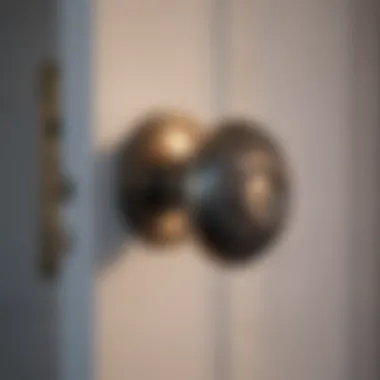
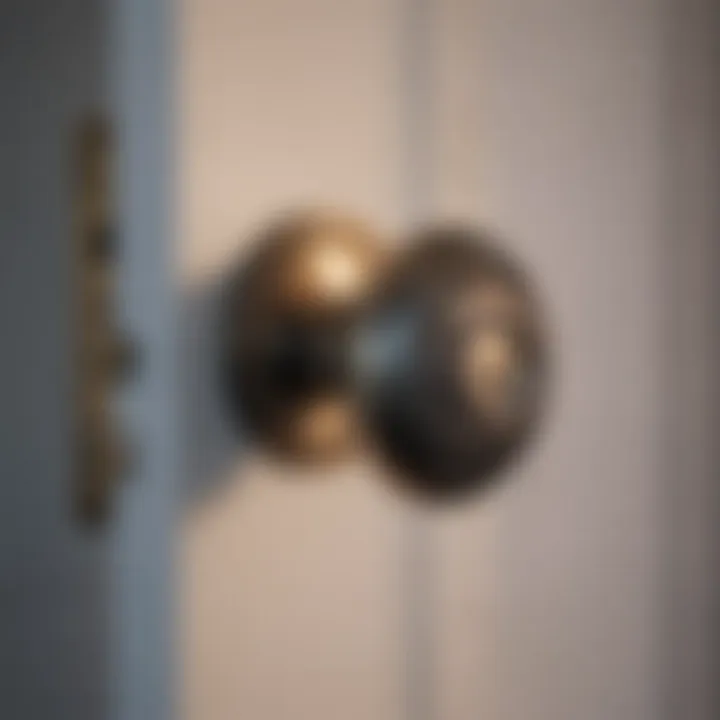
"Investing in quality doorknobs is like adding distinct strokes to the canvas of your homely sanctuary. Each turn and twist reveals a chapter of stories shared within those walls."
Combining functionality with aesthetic appeal, the right doorknob does not simply seal doors; they embody elements of security, usability, and sustainability. In every detail, these small items create a framework that enhances the living experience within a bedroom.
Materials Used in Doorknob Manufacturing
When it comes to doorknobs, the materials chosen play a critical role in both aesthetics and functionality. The choice of material not only shapes the visual appeal of a door but also determines how the knob performs in daily use. Understanding the myriad of options available helps homeowners make informed decisions that harmonize with their interior design while ensuring durability, security, and ease of maintenance.
Metal Options
Metal doorknobs are among the most popular choices, thanks to their strength and longevity. Common metals used include stainless steel, brass, and bronze, each offering unique characteristics.
- Stainless Steel: Known for its resistance to corrosion and rust, stainless steel doorknobs are ideal for spaces with high humidity, like bathrooms. They provide a sleek and modern look that fits well in contemporary homes.
- Brass: Often associated with traditional elegance, brass doorknobs develop a distinctive patina over time, adding character to any room. Although it may require more maintenance than stainless steel, the warmth of brass is hard to replicate.
- Bronze: Similar to brass in appearance, wrought bronze offers a more robust feel and is particularly popular in rustic or vintage settings. Its darker hue contributes to a sense of nostalgia and charm.
Choosing the right metal can reflect a homeowner’s personal style while ensuring that the doorknobs withstand the test of time.
Wooden Doorknobs
Though less common today, wooden doorknobs present a warm, organic feel to the bedroom. They can add a charming touch, especially in rustic or country-style homes. Various types of wood, like oak, cherry, or walnut, can be sculpted into unique designs.
The benefits of wooden doorknobs include:
- Insulation: Wood may provide better thermal insulation than metal, making it a cozy option for bedroom environments.
- Customizability: Wooden knobs can be stained, painted, or finished in countless ways to match the existing décor.
- Eco-Friendliness: Sourced from sustainable forests, wooden doorknobs appeal to environmentally conscious homeowners.
However, wood can be more prone to wear and tear, so it’s essential to consider maintenance when opting for this material.
Glass and Crystal Variants
Glass and crystal doorknobs have surged in popularity recently, bringing a touch of elegance and sophistication to interior spaces. Often crafted with intricate designs, these options can serve as standout features in any room.
A few aspects to keep in mind:
- Aesthetic Appeal: With their ability to refract light, glass knobs can transform the ambiance of a room, creating a sparkling effect that catches the eye.
- Fragility: While visually stunning, glass and crystal knobs are more susceptible to breaking. Care should be taken during installation and use to ensure their longevity.
- Variety of Styles: From vintage cut glass to sleek modern shapes, the options are endless, allowing homeowners to express their personal taste.
Ultimately, selecting the right material for bedroom doorknobs adds more than just functionality—it enhances the overall atmosphere, making the bedroom a sanctuary that reflects personal style and comfort.
"The right doorknob can be the final touch that ties a room together, ensuring that its beauty is both seen and felt."
As you explore your options, keep in mind the balance of aesthetics, function, and maintenance to find the perfect fit for your home.
Design Considerations for Bedroom Doorknobs
In the realm of home décor, the details often hold as much power as the bold statements made by prominent furniture or wall colors. This is particularly true when it comes to bedroom doorknobs, which may seem like a small component but actually play a significant role in both function and style. Choosing the right doorknob isn't simply about pulling a door open; it’s about creating harmony within the space, enhancing the aesthetics, and ensuring practicality.
When considering doorknob design, several factors come into play, such as the overall theme of the room, color palettes, and ergonomic concerns. Paying attention to these elements will lend not just to the functionality of the doorknob, but also to the ambiance and feel of the bedroom.
Matching Styles to Decor
One of the foremost considerations is how well a doorknob meshes with the existing decor styles of the bedroom. Is the room boasting a modern minimalist vibe, or does it echo vintage charm? Selecting a doorknob that mirrors or complements the prevailing style can effectively tie the room together. For example, vintage brass knobs can enhance a shabby chic or classic room, while sleek stainless-steel designs might suit a contemporary setup.
In some cases, contrasting styles can be effective. A bold, ornate doorknob can become a focal point in a neutral room, visually striking and adding character. Making this choice requires a keen eye, as balancing these elements can either elevate or disrupt the room’s harmony.
Color Schemes and Finishes
Color and finish are also paramount in your doorknob choice. The finish of a doorknob not only contributes to its visual appeal but can also impact its maintenance. For a rustic feel, consider a matte finish, while a polished chrome might afford a sleek, refined look. Additionally, incorporating colors that resonate with the room's palette can create a seamless transition that visually guides guests throughout the space.
A harmonious color scheme can offer cohesion—consider gold-toned knobs against deep navy walls for luxury or a simple black knob against light woodwork for understated elegance. The finish being selected should cater to not only style preference but also function—will it withstand daily use, or is it purely ornamental?
Ergonomic Factors
The functionality of doorknobs goes hand in hand with their design. Ergonomics shouldn't be skimped upon; doorknobs should feel comfortable and intuitive to use. After all, they'll be handled countless times. Opting for shapes that fit naturally in the palm of your hand can help prevent unnecessary strain, especially for those with mobility challenges. An elongated lever, for instance, might ease access compared to a knobby pull.
Furthermore, size matters. A doorknob should resonate with the scale of the door and the overall architecture of the room. A larger knob on a heavy wooden door may be harmonious, while a tiny knob on vintage cabinetry might feel quaint and appropriately proportioned. Prioritizing usability alongside style ensures that the elegance of the doorknob does not come at the expense of convenience.
"Style and function must go hand in hand, especially in spaces as personal as our bedrooms. A thoughtful approach to doorknob selection can elevate the entire experience of the room, making it both beautiful and accessible."
In summary, when considering bedroom doorknobs, take a moment to think about the style compatibility, color scheme, finish, and ergonomic design. Each decision contributes to how the space feels and functions, making it a sanctuary that truly reflects personal taste.
Installation Process of Doorknobs
The process of installing doorknobs may seem trivial in the grand scheme of interior design, but the reality is quite the opposite. A well-installed doorknob not only enhances the aesthetic of a bedroom but also contributes significantly to security and functionality. Whether you're switching out an old knob for a sleek, modern design or installing one for the first time, understanding this process gives you a sense of accomplishment and ensures your bedroom feels complete. This section will cover the crucial steps involved, ensuring that the doorknob you choose is both functional and aligns with your design vision.
Tools Required
Embarking on your doorknob installation journey requires some basic tools. Here's a list of essentials to have at hand:
- Screwdriver (typically a Phillips-head)
- Drill (if mounting is necessary)
- Chisel (for adjusting the door frame)
- Tape Measure (for precise measurements)
- Pencil (for marking holes)
- Level (to ensure your doorknob is straight)
Tip: Having a small flashlight can also be handy, especially in dimly lit areas.
These tools will help streamline your installation process, making it smoother and efficient. Having everything ready prevents unnecessary trips back to the toolbox.
Step-by-Step Guide
Once you've gathered your tools, it’s time to dive into the installation process. Follow these straightforward steps:
- Remove the Old Doorknob: If applicable, take off the existing doorknob by unscrewing it. You may need to hold the knob from the opposite side to loosen it completely.
- Measure the Door Thickness: Not all doors are created equal. Use your tape measure to ensure that your new doorknob fits perfectly. Most common doors are between 1.375 inches to 1.75 inches thick.
- Align the New Knob: Place the new doorknob within the existing space, checking that it aligns properly. For new installations, mark the location with your pencil.
- Drill the Holes: If you're installing a knob where one did not exist, drill the correct size holes where the marks are. Ensure that you keep the drill level, as an uneven installation can lead to problems down the line.
- Attach the Doorknob: Insert the doorknob through the holes from both sides of the door. Secure it tightly using screws from the inside, but be careful not to overtighten to avoid damaging the door.
- Test the Mechanism: Before closing the door, check if the knob turns smoothly and the locking mechanism works. Make any adjustments as needed.
- Finish Up: Once you’re satisfied, pop any decorative cover plates into place if your knob design has them.
This step-by-step guide provides clarity for those who may feel daunted by the thought of installing a doorknob. Take your time, enjoy the process, and in no time, you’ll have a beautifully functioning fixture.
Common Mistakes to Avoid
Even seasoned DIY enthusiasts can trip up when installing doorknobs. Here are common missteps that can easily be avoided:
- Not Measuring Properly: Jumping into installation without precise measurements can lead to misaligned components, necessitating further adjustments down the line. Always double-check dimensions.
- Ignoring the Door Swing: Failing to consider which way your door swings can result in a knob that’s awkwardly placed, making entry and exit cumbersome.
- Over-Tightening Screws: While it’s important to secure the doorknob, over-tightening can strip screws or warp the door material.
- Skipping the Test: Checking if everything functions before wrapping up the job can save you heartache later. Don't hesitate to wiggle the knob and test the locking mechanism before finishing.
- Neglecting Aesthetics: Choosing a doorknob that clashes with your decor might leave you dissatisfied. Consider how the style fits within your bedroom's overall design.
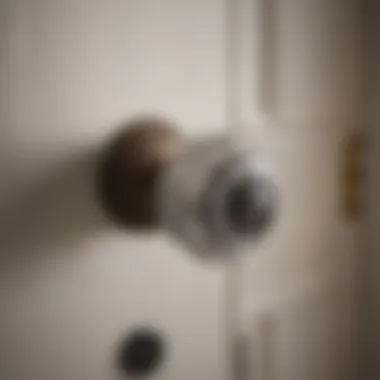
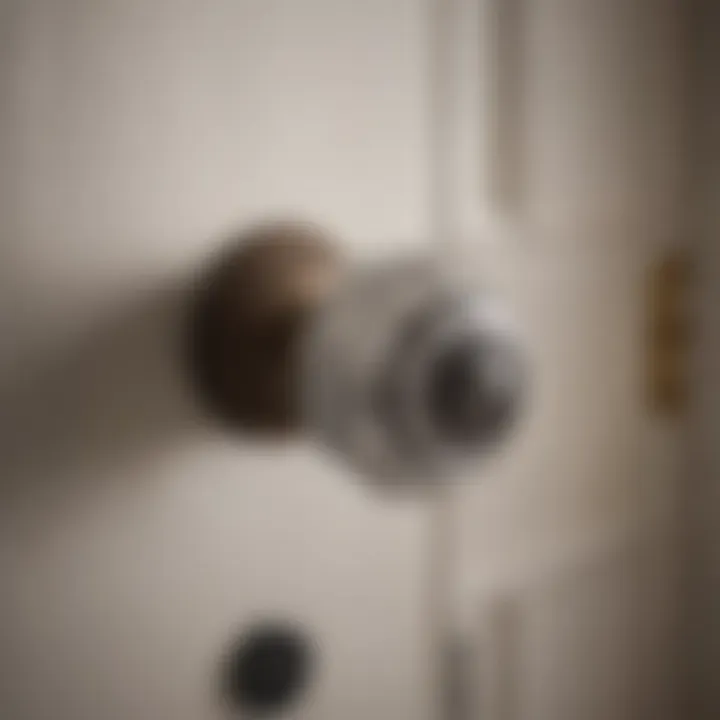
Avoiding these pitfalls can ensure a seamless installation experience, resulting in a doorknob that enhances both function and form in your bedroom environment.
Doorknab Trends in Modern Interior Design
When it comes to modern interior design, the details can make or break the overall ambiance. Bedroom doorknobs, often overlooked, play a significant role in this landscape. They are not just functional objects but also key components that contribute to a room's aesthetic. Today, styles are evolving rapidly, compelling homeowners to ponder what speaks to their design sensibilities.
Embracing doorknab trends gives one the chance to personalize spaces. Selecting one style over another can evoke a sense of comfort or even a focal point within a room. The range of options available today ensures that there is something for everyone's taste - whether one opts to evoke nostalgia or to embrace sleek modernity.
Vintage and Retro Inspirations
There's a certain charm in vintage and retro doorknobs that can transport you back in time. These pieces are often crafted with intricate details, showcasing craftsmanship that resonates with a bygone era. The allure of a brass doorknob with an ornate design could remind one of a Victorian home, creating a sense of warmth and familiarity.
- Vintage doorknobs come in a variety of styles and finishes.
- They can often be sourced from antique shops or flea markets, adding a one-of-a-kind element to a room.
Incorporating these doorknobs can significantly enhance the overall theme of a space, adding character without needing a complete makeover. Their unique stories can become conversation starters, highlighting the personality of the home.
Minimalist Approaches
In stark contrast to vintage styles, minimalist doorknobs shine with simplicity, reflecting the philosophy of less is more. These doorknobs prioritize function while embracing clean lines and muted finishes. They often feature materials like brushed stainless steel or matte black, which align with a modern aesthetic.
- A key benefit of opting for minimalist designs is their versatility.
- They seamlessly blend into a variety of decor styles, maintaining balance in a room.
This approach encourages an uncluttered look, promoting tranquility within the bedroom. Even though they appear understated, minimalist doorknobs carry an elegance that uplifts the overall design, making them a smart pick for contemporary homes.
Bold Statement Pieces
For those who dare to be different, bold statement pieces in doorknab design offer an exciting avenue for self-expression. Think vibrant colors, unconventional shapes, or even oversized designs that draw the eye. A brightly-colored ceramic knob or a uniquely sculpted metal piece can serve as a striking focal point.
- The impact of such doorknobs can redefine a bedroom’s vibe, making a daring statement.
- They can transform a simple entrance into a portal of visual interest, enticing visitors and inviting curiosity.
In a world where individuality is cherished, these doorknobs showcase personal style, telling the homeowner's story subtly yet effectively.
In summary, the trends in modern doorknobs invite everyone to think critically about choices that pertain to their spaces. Whether one leans towards vintage inspirations, embraces minimalism, or opts for bolder statements, doorknobs are the unsung heroes in sculpting the aesthetics of a home. As these trends continue to evolve, homeowners can find joy in exploring the nuances that make their interiors uniquely theirs.
The Intersection of Doorknobs and Home Automation
The advent of smart technology has touched every facet of our lives, including our homes. Among the various elements of home automation, doorknobs have stepped into the limelight, blending traditional function with the modern conveniences of automated systems. This intriguing intersection not only enhances security but also revolutionizes ease of access and personal convenience, making it a topic worthy of deeper exploration.
Smart Doorknob Options
The marketplace today showcases a wealth of smart doorknob choices, suitable for both tech enthusiasts and everyday users. These innovative devices often come equipped with features like keyless entry, which allows users to unlock doors with a smartphone app, a code, or even biometrics. Brands such as August and Yale are leading the charge with options that work seamlessly with existing smart home ecosystems.
It’s important to consider the various styles available. For example, some smart doorknobs maintain the traditional aesthetic of a regular knob, keeping the charm of a classic look while still functioning as modern technology. These doorknobs raise the question: How do we balance visual appeal with high-tech functionality? Choosing a smart doorknob that doesn't compromise on style can elevate the entire decor of your bedroom.
"In choosing a doorknob, you’re not just picking a piece of hardware. You’re defining a point of interaction with your space."
Integration with Security Systems
One of the most significant benefits of smart doorknobs lies in their ability to mesh perfectly with home security systems. Connecting your doorknob to an alarm or surveillance setup enhances security far beyond the conventional lock and key. Systems like Ring and Nest offer configurations where a doorbell camera can sync with your smart doorknob, alerting you to anyone approaching your home.
Moreover, some smart doorknobs come with remote monitoring options. Using these, homeowners can check the status of their doors while at work, on vacation, or even remotely manage access for guests. This dual-layer security not just aids in protecting your home but also provides peace of mind.
User Convenience and Accessibility
When discussing doorknob advances, it’s crucial to touch upon convenience and accessibility aspects. Smart doorknobs cater to a diverse array of users, helping those with mobility challenges or busy lifestyles. For instance, families can create temporary access codes for guests or service providers, eliminating the need for physical keys that are often lost or mismanaged.
Additionally, features like voice activation further simplify access. Imagine coming home with your hands full—being able to say "Open the door" without fumbling for a key is a game-changer for many. This kind of user-centric design caters to the realities of modern living while making homes more navigable and secure for everyone.
As we dig deeper into the role of technology in our living spaces, it becomes increasingly clear that doorknobs—often seen as an afterthought—deserve attention. Smart doorknobs represent more than just practical updates; they offer a window into a future where technology and design coexist harmoniously.
Comparative Analysis: Traditional vs. Modern Doorknobs
In the world of home décor, doorknobs often don’t receive the attention they deserve. However, their subtle presence plays a pivotal role in both functionality and aesthetic appeal within each room, particularly the bedroom. This analysis juxtaposes traditional and modern doorknobs, spotlighting key differences in design, functionality, and value.
Design Variations
When it comes to design, traditional doorknobs frequently embody classic craftsmanship, featuring intricate patterns, ornate curves, and sometimes even historical motifs. Take, for instance, the Victorian style. This design often employs brass and crystal materials, rendering them not only durable but also stunning focal points. On the flip side, modern doorknobs lean towards minimalism, leveraging clean lines and geometric shapes. Popular materials include stainless steel and matte finishes, emphasizing simplicity. While traditional knobs may evoke nostalgia, modern knobs represent a stark departure, tailored for contemporary spaces.
"The choice between traditional and modern doorknobs can define the entire mood of your space. A Victorian knob can bring warmth, while a sleek knob could deliver a crisp, fresh feel."
Functionality Differences
Functionality serves as a cornerstone when selecting a doorknob. Traditional doorknobs might require a bit more effort in terms of operation, particularly those with intricate mechanisms. They also tend to rely on a key or latch system, which can be cumbersome. In contrast, modern doorknobs often embrace user-friendly designs equipped with push-button or lock features that reduce the complexity. Many modern options also integrate smart technology, streamlining access and enhancing security. This shift not only augments ease of use but also aligns with today’s fast-paced lifestyle.
Value Appropriateness
Evaluating value is essential when comparing traditional and modern doorknobs. Generally, traditional doorknobs may command higher prices due to their craftsmanship, historical significance, and unique designs. A well-maintained Victorian knob can appreciate over time, becoming an investment piece alongside its decorative function. Meanwhile, modern doorknobs, though typically more affordable, present flexibility in terms of quantity and styles, allowing homeowners on a budget to revamp their spaces without breaking the bank. This aspect becomes crucial for families seeking both style and practicality without emptying their wallets.
In summary, understanding the distinct characteristics and benefits of traditional and modern doorknobs can significantly impact your choices when designing a bedroom oasis. The blend of design, functionality, and value should not be viewed in isolation; rather, they should be seen as interdependent elements that together create a cohesive and inviting atmosphere.
Maintenance Tips for Bedroom Doorknobs
Keeping bedroom doorknobs in tip-top shape is not just about aesthetics; it’s a matter of functionality and longevity. A well-maintained doorknob not only ensures smooth operation but also enhances the overall ambiance of your space. After all, these little items are the first and last point of contact when entering or leaving a room, making them crucial for a seamless experience. By understanding routine cleaning practices, lubrication techniques, and knowing precisely when to replace them, homeowners can skillfully maintain the integrity of their sanctuary.
Routine Cleaning Practices
A clean doorknob speaks volumes about the care you put into your space. Dust and grime tend to accumulate easily, and it’s amazing how much difference a little cleaning can make.
- Basic Cleaning Supplies: All that’s needed is a soft cloth, warm water, and mild soap. For metal knobs, a dab of vinegar can also work wonders. For those stubborn dirt spots, a little baking soda mixed with water can do the trick.
- Technique: Start by dampening the cloth with soapy water. Wipe down the doorknob thoroughly. Make sure to disinfect with rubbing alcohol to kill bacteria and germs. When cleaning glass or crystal doorknobs, gentle glass cleaner works well too. It’s like putting a shiny bow on a box!
- Frequency: Aim to clean your doorknobs at least once a month, or more often if you have children or pets in the home. This regular maintenance can prevent tougher messes from building up.
Lubrication Techniques
Lubrication may not always be the first thing that comes to mind with doorknobs, but it’s a vital step in preventing wear and tear over time. Here’s how to go about it:
- Choose the Right Lubricant: Silicone spray and graphite powder are the best choices. Avoid oil-based products as they might attract dust and gunk.
- Application Process: First, remove the doorknob if needed. Apply lubricant to the keyhole, latch, and any moving parts. If you’re using silicone spray, a quick squirt will do, and for graphite powder, a light sprinkle works wonders.
- Check Movement: After applying, operate the doorknob to ensure even distribution of the lubricant. A properly lubricated doorknob should turn smoothly without any hindrances.
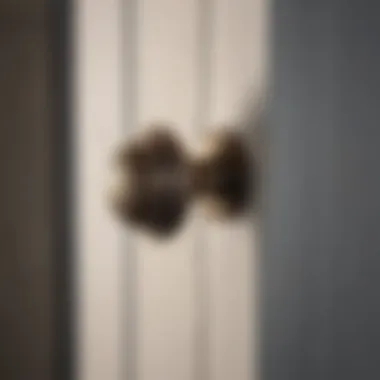
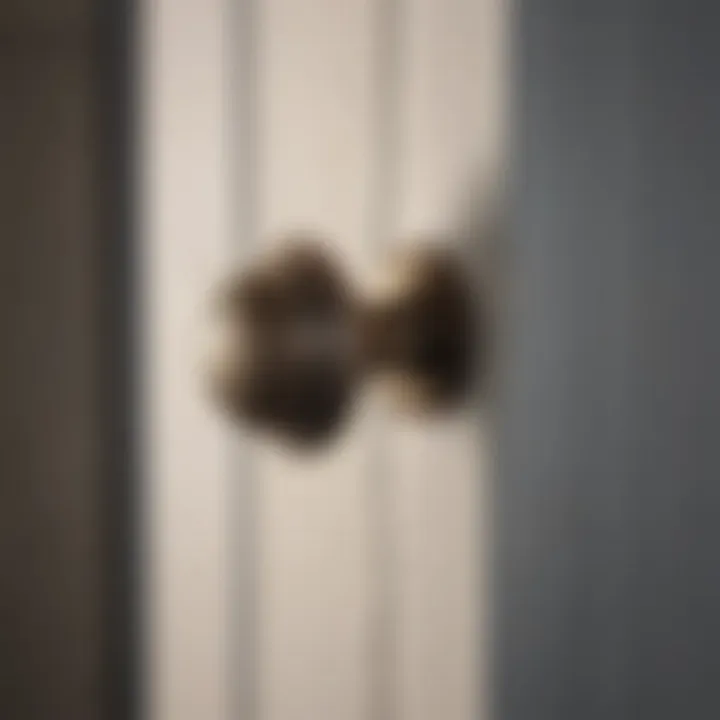
When to Replace Doorknobs
Sometimes, no amount of cleaning or lubrication will solve the issues at hand. Recognizing when it’s time to wave goodbye to an old doorknob is essential:
- Signs of Wear: If you notice cracks, rust, or it’s becoming loose, it might be time to consider replacing it. A doorknob that sticks or squeaks can be frustrating and may signal underlying problems.
- Frequent Malfunctions: If you find yourself struggling to open or close the door, or if the doorknob feels unusually hot or cold, it’s a red flag.
- Upgraded Style: Sometimes, it’s about style too. If you’ve revamped your bedroom decor and your old doorknob sticks out like a sore thumb, updating it can tie everything together beautifully.
Maintaining the small details, like doorknobs, creates a harmonious environment, showcasing mindfulness and care in your space.
Case Studies: Impact of Doorknob Choices
Understanding the choice of doorknobs in various projects can illuminate their subtle but significant impact on a bedroom's overall aesthetic. Doorknobs are often dismissed as mere functional hardware, but, in truth, they can serve as powerful design elements that reflect personal style. This section explores how specific doorknob selections have transformed not only the visual appeal but also the atmosphere of different spaces, providing concrete examples where the right choice made a world of difference.
Transformational Projects
Consider the renovation of a Victorian home in a historical district. The owners wanted to maintain authenticity while adding a modern twist. By selecting vintage-style brass doorknobs, they honored the home's history. However, these knobs were fitted with modern locking mechanisms, marrying the old and new seamlessly. The results were remarkable: the project gained positive attention on social media, and the brass doorknobs became a talking point for visitors.
Moreover, in a recent project involving a minimalist apartment conversion in an urban setting, the designer opted for sleek, matte-black doorknobs. This decision spoke volumes, offering a stark contrast to the light-colored wood doors and creating a cohesive modern look. This choice not only enhanced the aesthetic appeal but also improved functionality, making the spaces feel larger and more open.
Before and After Scenarios
Often, a small detail like a doorknob can lead to drastic changes in perception. Take, for instance, a bedroom that once featured traditional round handles. The decor was rich with textures, yet the round handles felt out of place. After replacing them with elegant crystal knobs, the entire atmosphere shifted.
"It’s amazing how just swapping out the hardware could create such a vibrant change in my space," one homeowner reflected post-renovation. Now, her bedroom exudes an inviting charm, resonating with the surrounding elements while enhancing the overall experience.
Another illustrative example involves a young family that wanted to move away from a dated look in their child’s room. The original doorknobs were oversized and heavily ornate, pulling focus from the cheerful decor. Upon replacing them with bright, painted wooden knobs, the transformation was startling. Suddenly, the room felt cheerful and light-hearted, contributing to a whimsical feel without overwhelming other design elements.
Expert Testimonials
Interior designers frequently advocate for thoughtful doorknob selection. Designer Rachel Lin emphasizes, "Doorknobs are often the unsung heroes of home design. They can either clash or complement your scheme. An informed choice can tie the whole room together."
Similarly, architect Tom Field articulated a shared belief: "In my work, I observe how even the smallest details can pivot a project from ordinary to extraordinary. Choosing the right doorknob often brings added character and coherence to the space."
Through these examples and expert testimonials, we see a common thread: each choice we make—right down to the doorknob—has repercussions in how a space is perceived and utilized. This intricate relationship between design choice and ambiance cannot be overstated, making case studies a vital part of understanding the impact of doorknob choices.
Sustainable Choices in Doorknobs
In recent years, the importance of sustainability in all areas of our lives has drawn increased attention. From the food we consume to the products we buy for our homes, the push for environmentally friendly choices has become paramount. When it comes to bedroom doorknobs, we often overlook these small fixtures, but they can have a significant impact on our ecological footprint. Making sustainable choices regarding doorknobs is not just a passing trend; it reflects a deeper commitment to protecting our environment.
Choosing sustainable doorknobs includes considering their materials, the manufacturing processes used, and their long-term impact on waste. Homeowners today are more aware of the considerable effects that seemingly minor decisions can have on the environment. Here are a few specific elements to consider when opting for sustainable doorknobs:
- Reduction of Carbon Footprint: By selecting products made from eco-friendly materials, one contributes to the reduction of greenhouse gas emissions that result from conventional manufacturing methods.
- Promoting Responsible Consumption: Supporting manufacturers that prioritize sustainability encourages more businesses to adopt eco-friendly practices.
- Long-term Savings: Sustainable choices can be cost-effective in the long run, as they often involve durable materials that require less frequent replacement.
Making a conscious effort to choose sustainable doorknobs is a simple yet effective way to promote environmental stewardship in your home.
Eco-Friendly Materials
The materials used in doorknob production have a direct impact on their environmental footprint. Opting for eco-friendly materials not only benefits the environment but can also enhance the aesthetic appeal of your bedrooms. Here are some key points to consider:
- Bamboo and Recycled Wood: Not only is bamboo a rapidly renewable resource, but it also adds a touch of nature to any decor. Similarly, using recycled wood can provide a unique and rustic charm to your doorknobs while reducing tree cutting.
- Recyclable Metals: Metals like brass or stainless steel have a long lifespan and can be fully recycled, contributing to a circular economy where materials are repurposed rather than discarded.
- Bio-Based Plastics: Some manufacturers are turning to bio-based plastics made from renewable resources. These materials can reduce dependency on petroleum while offering a similar durability to traditional plastics.
Sustainable Manufacturing Practices
It isn’t just about the materials; the manufacturing practices also play a crucial role in sustainability. Here are some aspects that demand attention:
- Energy-Efficient Production: Look for companies that utilize processes that minimize energy consumption, which can drastically reduce the overall impact on the environment.
- Water Conservation Techniques: Manufacturers committed to sustainability will often implement processes that conserve water. This is particularly important in regions where water is scarce.
- Waste Reduction Strategies: Sustainable companies strive to minimize waste during production by reusing scraps and finding innovative ways to repurpose leftover materials.
These practices not only help in environmental preservation but also often lead to better quality products.
Longevity and Recyclability
One of the most overlooked aspects of sustainable doorknobs is their lifespan. Choosing doorknobs designed to last reduces the frequency of replacements, which significantly lessens waste. Consider the following:
- Durable Materials: High-quality doorknobs made from resilient materials save you from continual replacements, therefore sparing additional resources needed for production.
- Recyclability: When the time eventually comes for replacement, the ability to recycle your doorknobs contributes to sustainability. Always check if the materials can be recycled and if the manufacturer offers a take-back program.
- Upcycling Potential: Creative homeowners can find ways to upcycle old doorknobs into unique decorative items or functional pieces around the home, ensuring that they don’t end up in a landfill.
In sum, these considerations present a compelling case for selecting sustainable options when it comes to bedroom doorknobs. By being mindful of the materials, manufacturing processes, and longevity of products, homeowners can play their part in protecting the environment while enhancing the aesthetic appeal of their homes.
Future Directions in Doorknob Design
As the age of technology surges forward, the design of doorknobs is no longer confined to mere function; it is becoming interlaced with technological advancement, innovative designs, and evolving consumer preferences. This section examines how these elements are shaping the future of doorknob design. We will touch on how emerging technologies are redefining access and security, the predictions that designers and architects are making for the coming years, and what the modern consumer is increasingly looking for. All of these factors contribute to creating a versatile and attractive addition to bedroom aesthetics, emphasizing that even the smallest details matter in interior design.
Emerging Technologies
Emerging technologies are altering the landscape of doorknob manufacturing and functionality. The integration of smart technology into everyday fixtures, including doorknobs, enhances user convenience and security. For instance, smart doorknobs enable keyless entry, allowing homeowners to control access remotely. This technology not only adds a layer of safety but also streamlines everyday life.
Some noteworthy advancements include:
- Biometric locks: These doorknobs use fingerprint scanning for maximum security.
- Bluetooth connectivity: They can connect to smartphones, allowing for remote unlocking with a simple tap.
- Voice activation: With compatible smart home systems, users can unlock their doors through voice commands.
Not only do these innovations appeal to tech-savvy homeowners, but they can also significantly increase the property value in a competitive market.
Design Predictions
The aesthetic aspect of doorknobs is also evolving rapidly. Top designers predict a shift towards simpler, sleeker designs that still make a statement. As people move into smaller living spaces, there’s a growing preference for minimalist aesthetics. Thus, doorknobs are expected to become more understated yet elegant, fitting seamlessly into a range of décors.
Some design trends to watch for include:
- Mixed materials: The combination of wood, metal, and glass for a custom feel.
- Artistic shapes: Unique forms that can serve as conversation pieces in a room.
- Eco-conscious designs: Increasing demands for sustainable materials in doorknob production, driving the design towards more earth-friendly choices.
These predictions emphasize the essential role that style plays alongside functionality. A thoughtfully designed doorknob can be a focal point in a room rather than just a utilitarian object.
Consumer Preferences
As with any design element, consumer preferences continuously shift based on lifestyle and cultural trends. Homeowners today are drawn to doorknobs that reflect their unique tastes and align with their values. There’s a notable inclination towards personalization, with many seeking custom options that enhance their home’s individuality.
Key preferences expressed by modern consumers include:
- Customization options: Consumers want the freedom to select finishes, shapes, and textures that resonate with their personal style.
- Focus on durability: With stronger emphasis on quality, buyers are looking for long-lasting fixtures that combine beauty with resilience.
- Sustainability: Eco-friendly materials and processes have become a significant consideration; many homeowners prefer brands that prioritize sustainable practices.
The demand for personal expression in interior design is almost as crucial as the practical aspects of a home, showcasing how doorknobs could embody this shift in consumer mindset.
The trends in consumer preferences serve as a guiding light to manufacturers, urging them to embrace innovation while remaining sensitive to the desires of an increasingly design-conscious public.



